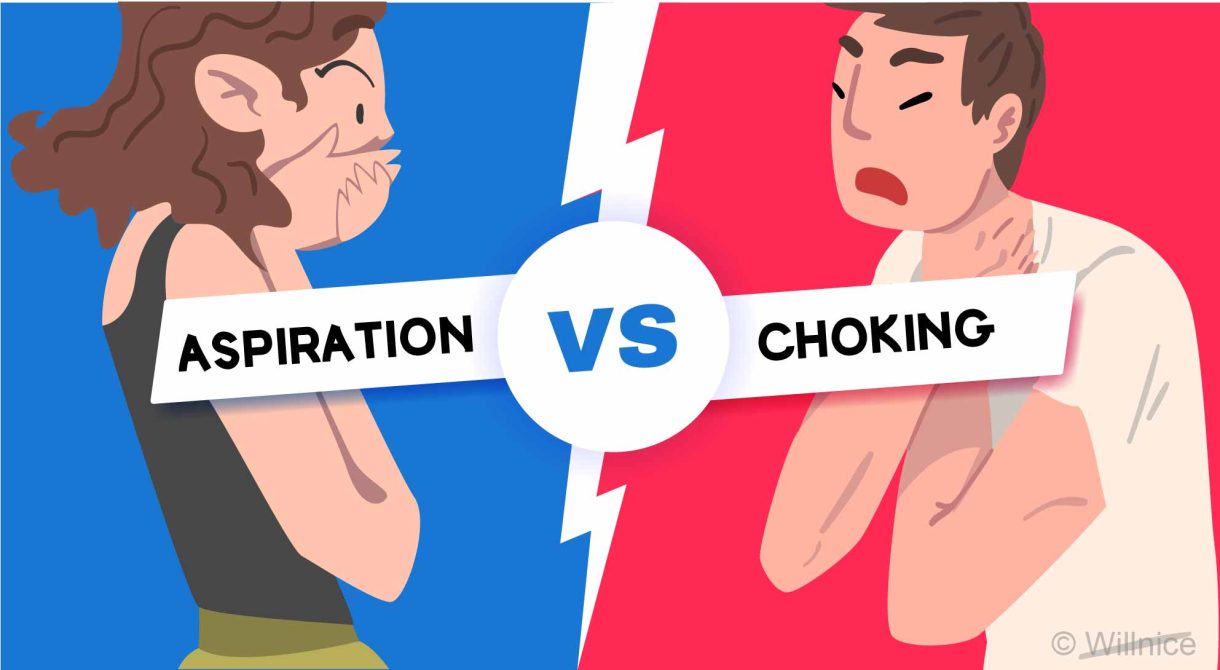
Aspiration and choking both involve respiratory issues, with both similarities and distinctions between them. Globally, many people die each year from aspiration and choking, particularly children and the elderly. In fact, individuals over the age of 65 are seven times more likely to choke on food due to aspiration compared to children aged 1-4.
It is essential to understand the concepts of aspiration and choking, to focus on prevention, and to provide effective first aid when harm occurs.
What is Aspiration?
Aspiration refers to the process where varying amounts of liquid or solid food, secretions, and other materials enter the airways and lungs below the vocal cords during swallowing. It is classified into overt aspiration and silent aspiration.
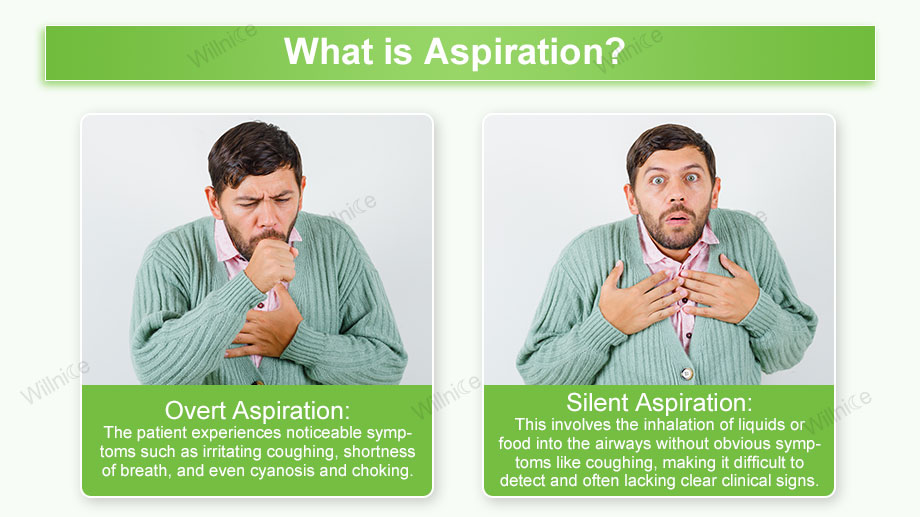
- Overt Aspiration: The patient experiences noticeable symptoms such as irritating coughing, shortness of breath, and even cyanosis and choking.
- Silent Aspiration: This involves the inhalation of liquids or food into the airways without obvious symptoms like coughing, making it difficult to detect and often lacking clear clinical signs. Silent aspiration occurs more frequently than overt aspiration but is less likely to be identified clinically, leading to a higher risk of missed diagnoses.
Signs of Overt Aspiration
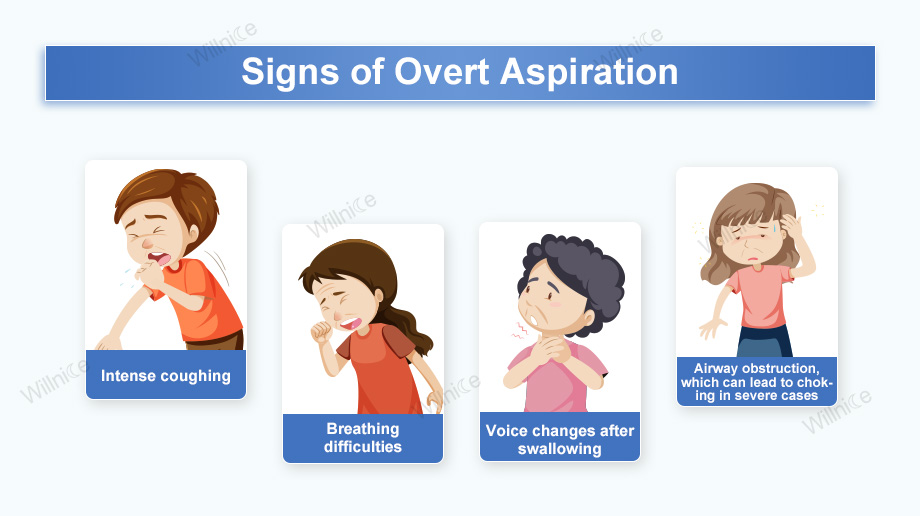
- Intense coughing
- Breathing difficulties
- Voice changes after swallowing
- Airway obstruction, which can lead to choking in severe cases.
Signs of Silent Aspiration
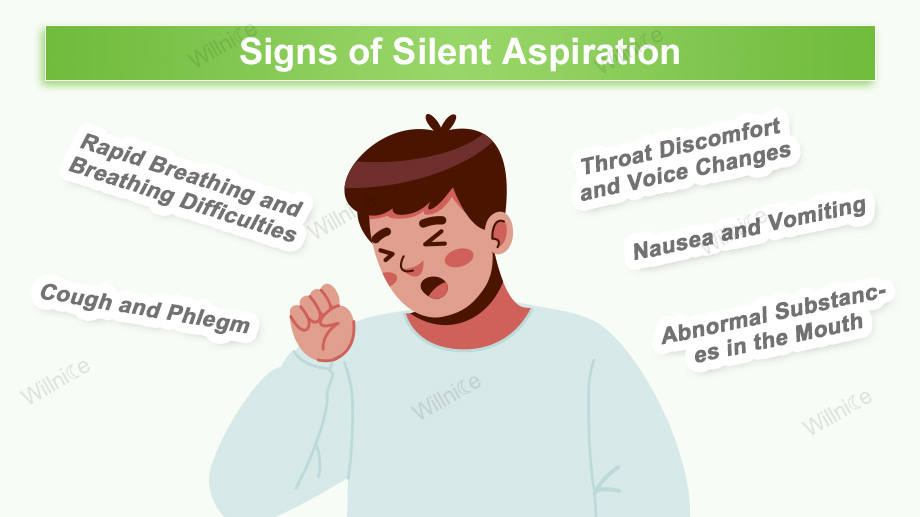
- Rapid Breathing and Breathing Difficulties: When foreign objects enter the trachea, patients may experience rapid breathing and difficulties, which are the most apparent symptoms of silent aspiration.
- Cough and Phlegm: After aspiration, patients typically exhibit a forceful coughing response to clear foreign objects from the trachea, accompanied by the production of a significant amount of phlegm.
- Throat Discomfort and Voice Changes: Due to irritation in the throat, patients may feel discomfort, pain, or a burning sensation, and may exhibit changes in voice, such as hoarseness or wheezing.
- Nausea and Vomiting: Aspiration can cause stomach contents to reflux back into the mouth, leading to nausea and vomiting.
- Abnormal Substances in the Mouth: The appearance of unusual substances in the mouth, such as phlegm, blood, or food, may be due to aspiration.
What Causes Aspiration?
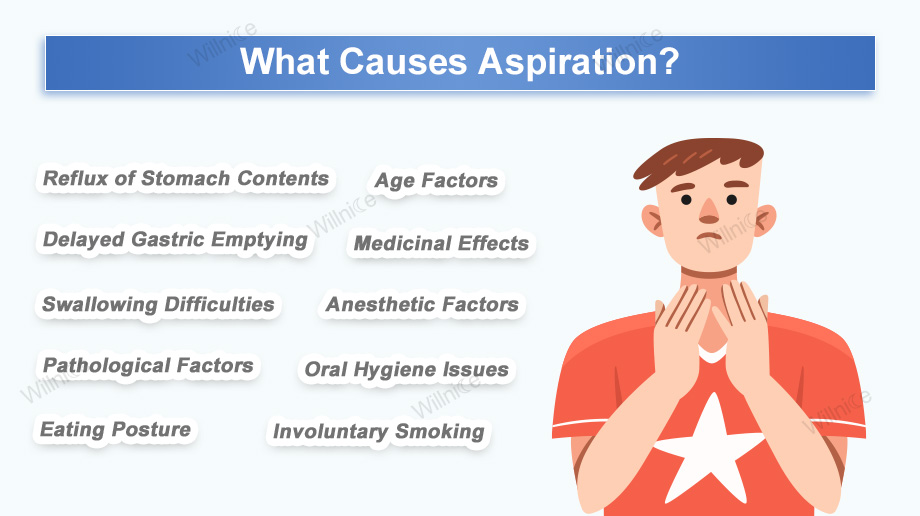
- Age Factors: Infants and toddlers have underdeveloped swallowing functions, making them prone to aspiration during eating; elderly individuals may experience relaxation of the esophageal sphincter, reduced throat sensation, and weakened swallowing and cough reflexes, all of which can increase the risk of aspiration.
- Pathological Factors: Certain conditions, such as cerebrovascular accidents, impaired consciousness, and prolonged bed rest, can impair swallowing function and increase the likelihood of aspiration.
- Eating Posture: Incorrect postures, such as lying down or tilting the head back while eating, can increase the risk of aspiration.
- Swallowing Difficulties: Esophageal disorders, neurological diseases, and muscle weakness can cause difficulties in swallowing, leading to the risk of food or liquid mistakenly entering the respiratory tract.
- Delayed Gastric Emptying: The time it takes for the stomach to empty can depend on the amount and type of food consumed, and delayed gastric emptying is a significant factor in aspiration.
- Anesthetic Factors: During general anesthesia, the loss of consciousness and the absence of pharyngeal reflexes can lead to a high incidence of reflux aspiration.
- Medicinal Effects: Certain medications, such as antipsychotics and theophylline, can reduce the pressure of the esophageal sphincter, increasing the risk of aspiration.
- Reflux of Stomach Contents: Reflux of stomach contents is a significant cause of aspiration, especially when the patient is lying flat or the head of the bed is too low.
- Involuntary Smoking: Smoking or exposure to second-hand smoke can increase the risk of silent aspiration.
- Oral Hygiene Issues: Bacteria in the mouth can easily cause infections, and regular oral care and check-ups can help prevent aspiration.
Substances That May Cause Aspiration
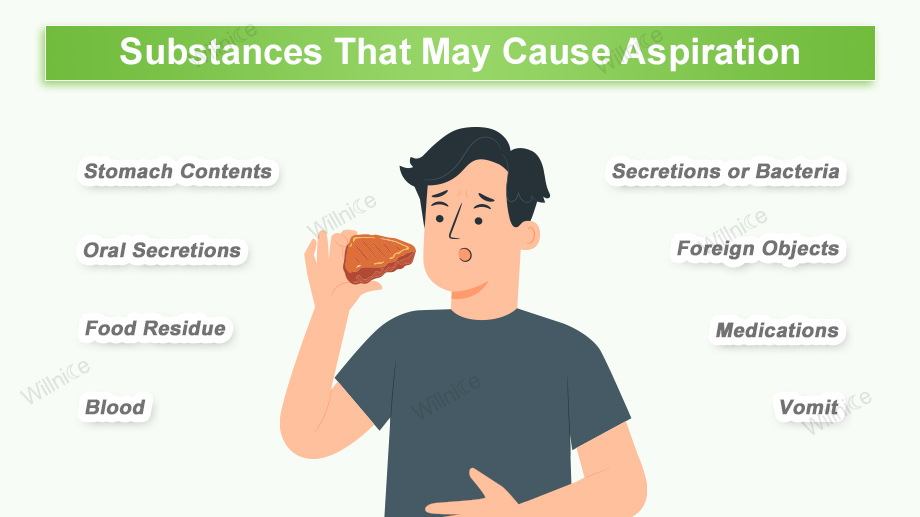
- Food Residue: During the swallowing process, if food is not completely chewed or swallowed improperly, food residues may inadvertently enter the airway.
- Oral Secretions: Secretions in the mouth, if not properly swallowed or expelled, may also enter the airway.
- Stomach Contents: Due to gastroesophageal reflux or other reasons, stomach contents may reflux into the laryngeal vestibule and then be aspirated into the trachea.
- Blood: In certain cases, such as vomiting blood, blood may be aspirated into the airway.
- Vomit: During vomiting, stomach contents may quickly reflux and be aspirated into the airway, especially when the patient is lying on their back.
- Medications: Certain medications may cause relaxation of the esophageal sphincter or affect normal gastrointestinal motility, increasing the risk of aspiration.
- Secretions or Bacteria: In cases of respiratory infections or other pathological states, secretions or bacteria may enter the airway.
- Foreign Objects: Non-food foreign objects, such as small parts of toys, may also be aspirated into the airway, particularly in children.
What is Choking?
Choking, also known as foreign body airway obstruction (FBAO), occurs when external objects or secretions block the airway, preventing air from entering the lungs for ventilation, thus affecting normal breathing. In severe cases, this obstruction can lead to choking and even death within minutes.
Signs of Choking
- Difficulty Breathing: Due to airway obstruction or impaired respiratory function, the patient may experience difficulty inhaling or exhaling, rapid breathing, or gasping.
- Cyanosis: A decrease in oxygen and an increase in carbon dioxide in the blood can cause the skin, lips, and nail beds to turn blue or purple.
- Coughing: If there is a foreign object or irritant in the airway, the patient may have severe or weak coughing.
- Impaired Consciousness: As hypoxia worsens, the patient may experience confusion, disorientation, or loss of consciousness.
- Abnormal Heart Rate: Initially, there may be an increase in heart rate; as choking progresses, the heartbeat may become weak or even stop.
- Muscle Spasms: Due to oxygen deprivation, the patient may experience muscle spasms or convulsions.
- Drooling or Vomiting: Choking may lead to increased saliva production or a vomiting reflex.
- Facial Swelling: Due to the accumulation of carbon dioxide and vasodilation, the choking person's face may appear swollen.
- Flaring Nostrils: In the final stages of breathing, the patient may exhibit flaring nostrils, a visible expansion and contraction of the nostrils during breathing.
- Generalized Spasms: At certain stages of choking, the patient may experience generalized body spasms.
- Blood Pressure Changes: There may be an initial increase in blood pressure, followed by a decrease.
- Pupillary Response: Choking may cause dilated pupils with weakened or absent light response.
- Physical Response: The choking person may exhibit weakness, reduced activity, or no movement.
- Abnormal Crying: In newborns, choking may cause weak crying or absence of crying sounds.
- Feeding Difficulties: Newborns experiencing choking may gag during feeding or refuse to feed.
- Hands in a "V" Shape at the Throat: The patient may involuntarily place one or both hands in a "V" shape against the throat.
Possible Causes of Choking
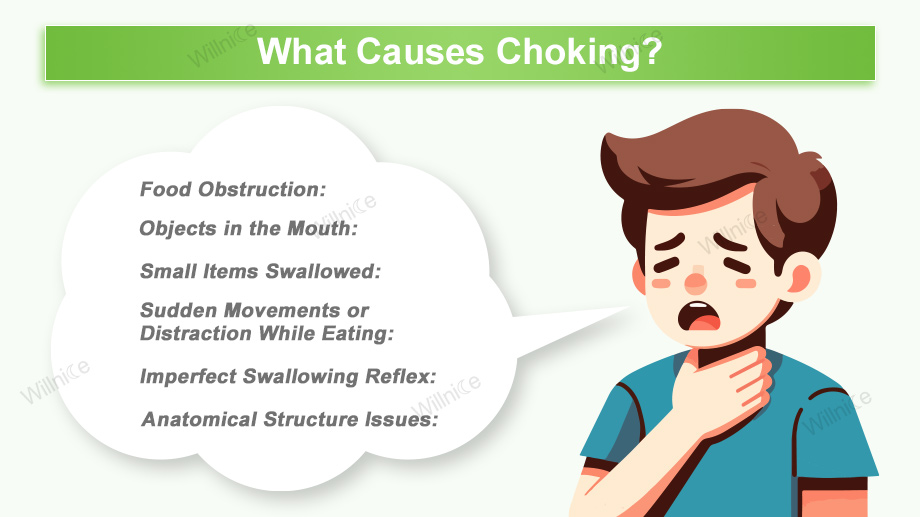
- Food Obstruction: The most common cause of choking in adults is food, such as a large piece of meat or other hard-to-chew foods.
- Small Items Swallowed: Infants and children may choke on small objects such as toys, coins, beans, and nuts.
- Sudden Movements or Distraction While Eating: Vigorous activity or sudden shock while eating can cause food to accidentally enter the airway.
- Imperfect Swallowing Reflex: Infants' swallowing reflexes are not yet fully developed, making it easy for them to choke on small, round foods.
- Objects in the Mouth: Children may inadvertently inhale objects into their airway while playing or crying with items in their mouths.
- Nature and Location of Foreign Objects: The nature of the foreign object and its position in the airway can cause different degrees of obstruction and symptoms.
- Anatomical Structure Issues: Certain anatomical abnormalities, such as enlarged tonsils, may increase the risk of food being aspirated.
Common Substances That Cause Choking
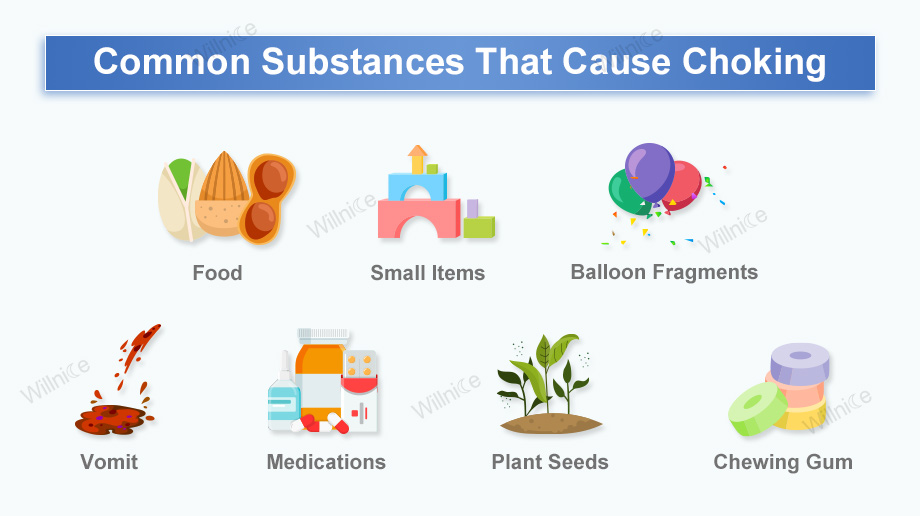
- Food: Items like nuts, grapes, popcorn, hard candy, and hot dogs can easily block the airway due to their shape and size.
- Small Items: Small objects such as coins, toy parts, pen caps, and button batteries might be inhaled by children while playing.
- Balloon Fragments: Pieces of burst balloons can be inhaled, causing airway blockage.
- Vomit: During vomiting, the vomit may reflux back into the airway.
- Medications: The size and shape of certain pills or capsules may cause swallowing difficulties, especially for children and the elderly.
- Plant Seeds: Seeds from certain plants might cause choking if inhaled into the airway.
- Chewing Gum: If swallowed accidentally, gum can form an obstruction in the airway.
Choking First Aid Measures
1. Assess the Situation:
- Quickly check if the choking person shows signs and symptoms of choking, such as inability to speak, difficulty breathing, or bluish complexion.
2. Emergency Medical Assistance:
- Immediately give fist aid if choking is confirmed and call 911.
3. Encourage Coughing:
- If the person is conscious and can cough, encourage them to cough forcefully to try to expel the foreign object.
4. Give Back Blows:
- If coughing is ineffective, administer back blows to help dislodge the object.
- Stand behind the person, slightly lean them forward, and give 5 firm blows between their shoulder blades with the heel of your hand.
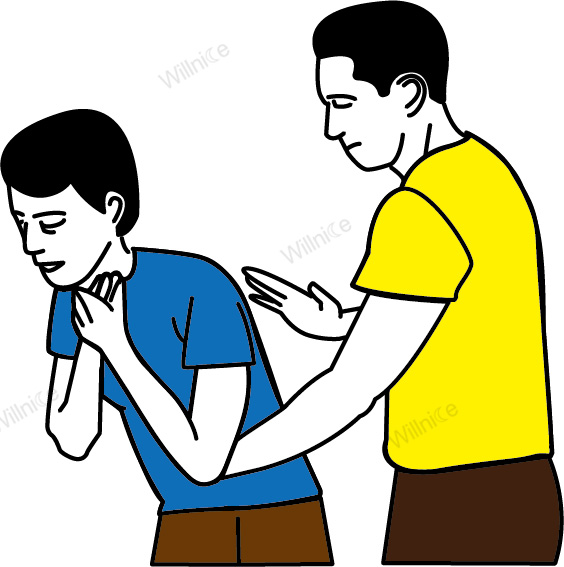
5. Perform Heimlich Maneuver:
- Stand behind the choking person, place a clenched fist between the ribcage and navel, grasp this fist with your other hand, and perform a quick, upward and inward thrust.
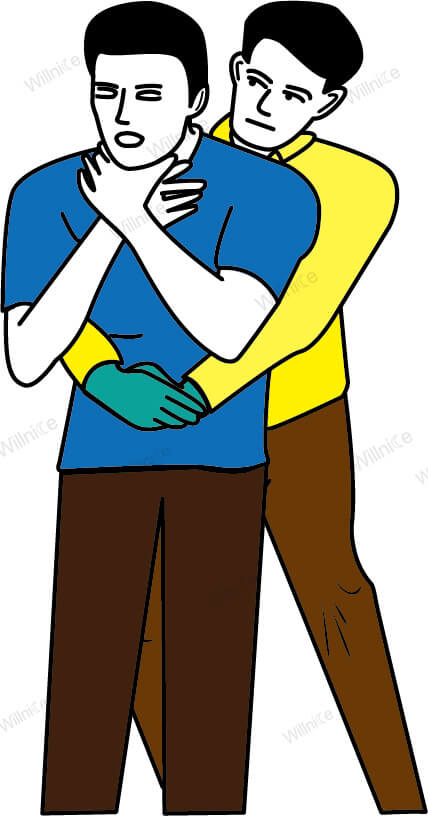
- Place the infant face down on your lap with their head lower than their body, and give five firm back blows between the shoulder blades.
- If ineffective, turn the infant face-up and apply five quick chest thrusts using two fingers at the sternum.
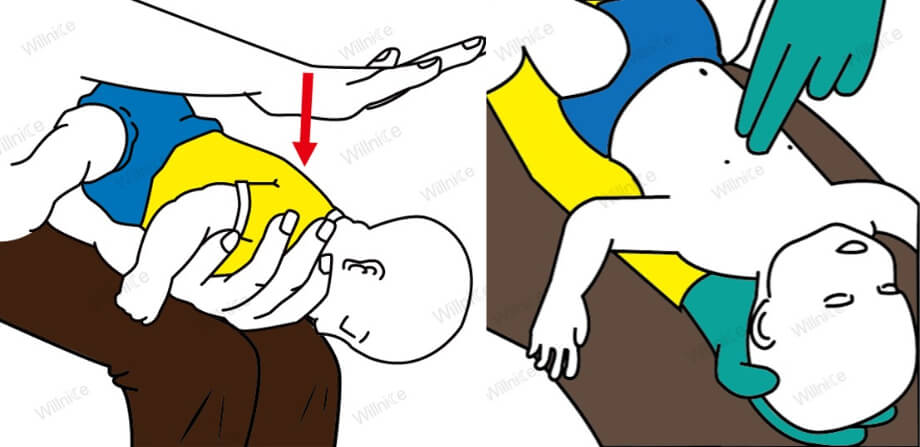
- Perform chest thrusts instead, targeting the middle of the sternum.
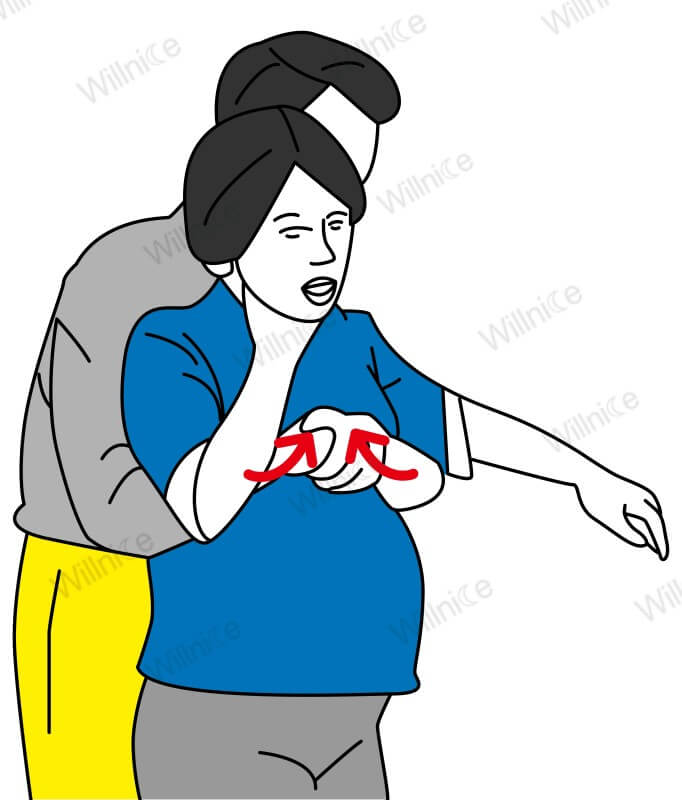
- If alone, perform abdominal thrusts.
- Make a fist and position it just above your navel. Clasp this fist with your other hand.
- Then lean forward over a firm surface such as a countertop or the back of a chair.
- Quickly thrust your fist inward and upward to dislodge the obstruction.
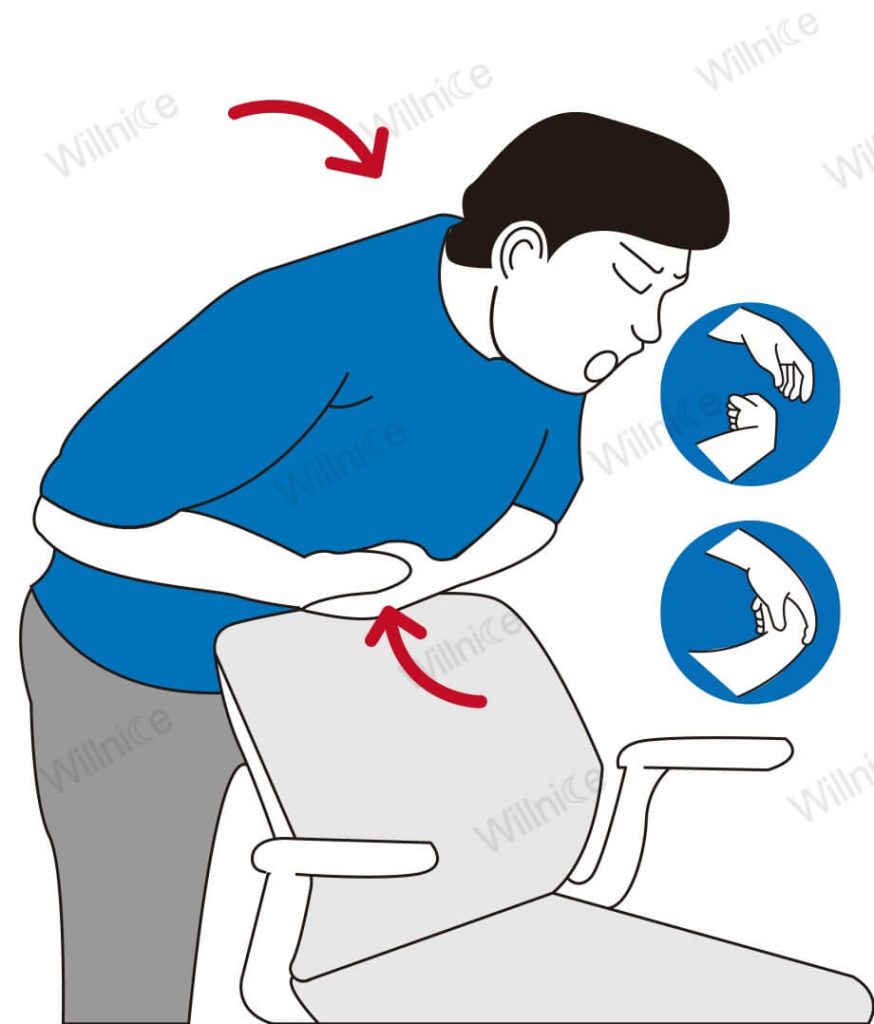
7. Use Professional Anti-Choking Device:
- If the Heimlich maneuver fails to remove the obstruction, consider using a professional choking suction device to clear it.

Note:
- Do not give water to a choking person as it may exacerbate the blockage.
- Monitor vital signs like breathing, pulse, and consciousness while waiting for emergency responders.
8. Cardiopulmonary Resuscitation (CPR):
- If the patient loses consciousness and is unresponsive, immediately start CPR.
Preventive Measures for Aspiration and Choking
- Proper Food Preparation: Cut food into small strips to ensure it is easy to chew and swallow.
- Eat Quietly: Avoid distractions while eating, such as talking, laughing, or running, as these activities increase the risk of aspiration.
- Child Supervision: Do not provide small toys or easily crumbled food to young children, and ensure they eat under adult supervision.
- Thorough Chewing: Chew slowly and thoroughly to ensure food is well chewed before swallowing.
- Mind Food Hardness: Avoid giving overly hard foods to young children or individuals with swallowing difficulties.
- Avoid High-Risk Foods: Some foods, such as nuts, grapes, popcorn, and hard candies, are considered high-risk and should be given to children and the elderly with caution.
- Use Assistive Tools: For individuals with swallowing difficulties, use assistive tools or adjust the texture of food to help them eat safely.
- Regular Oral Care: Regular oral hygiene can reduce bacteria in the mouth and prevent aspiration.
- Increase Awareness: Raise awareness about the risks of airway obstruction due to foreign objects, especially among high-risk groups such as children and the elderly.
- First Aid Training: Encourage family members and educators to participate in first aid training to learn how to assist in the event of choking.
Conclusion
Aspiration and choking are both respiratory health issues. Aspiration involves food entering the airway, which may not necessarily lead to choking, and the patient might still be able to breathe; whereas choking involves foreign obstructions stuck in the airway, obstructing airflow and causing difficulty breathing.
Both have connections and differences, requiring correct identification, first aid treatment, and preventive measures to reduce the occurrence of such events.


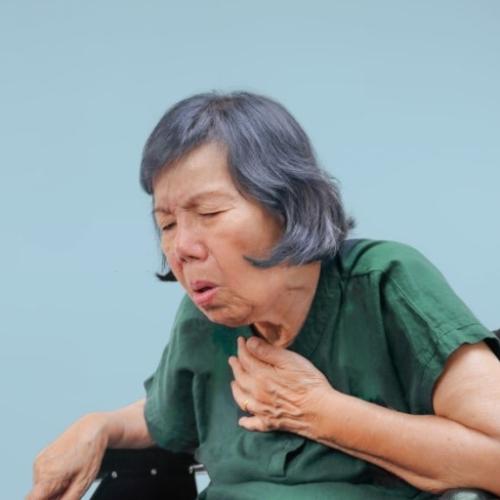
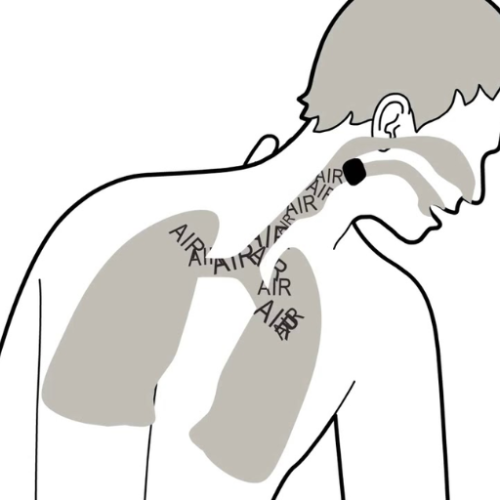
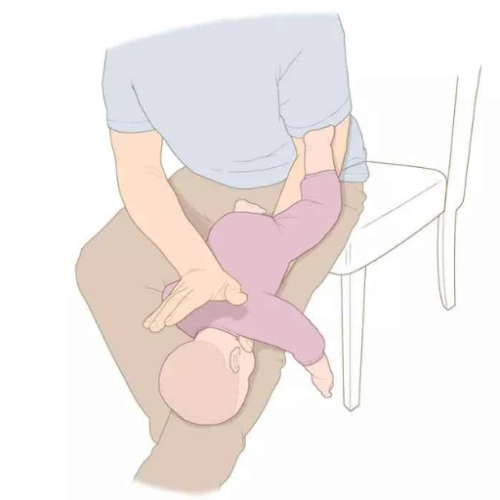

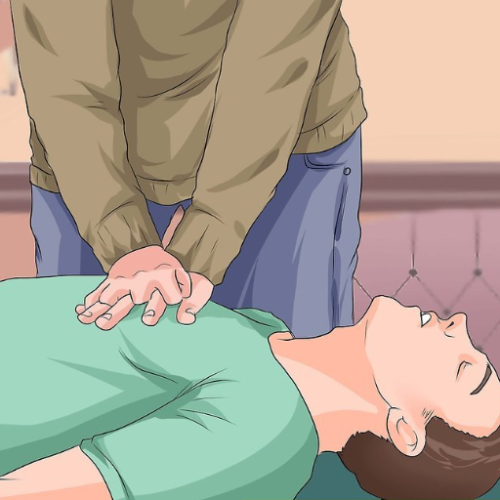
 Login with Google
Login with Google Login with Facebook
Login with Facebook